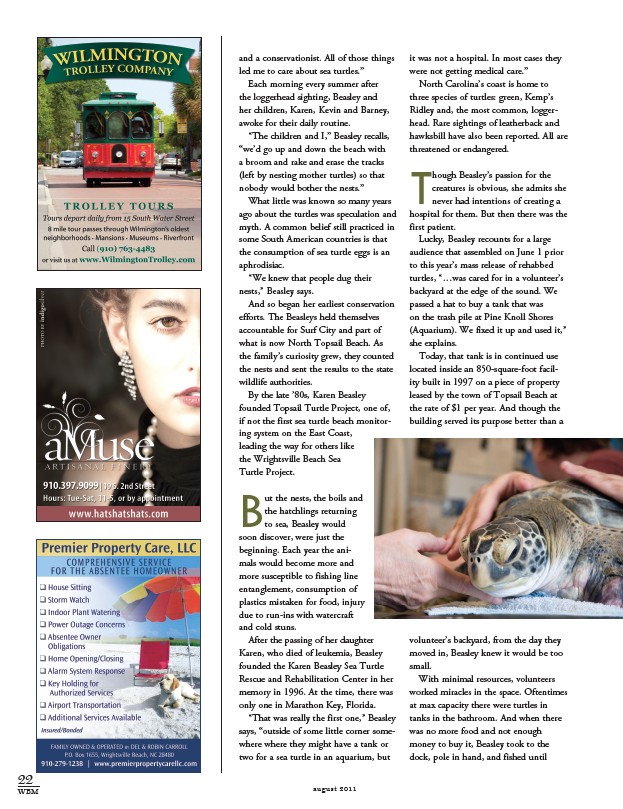
and a conservationist. All of those things
led me to care about sea turtles.”
Each morning every summer after
the loggerhead sighting, Beasley and
her children, Karen, Kevin and Barney,
awoke for their daily routine.
“The children and I,” Beasley recalls,
“we’d go up and down the beach with
a broom and rake and erase the tracks
(left by nesting mother turtles) so that
nobody would bother the nests.”
What little was known so many years
ago about the turtles was speculation and
myth. A common belief still practiced in
some South American countries is that
the consumption of sea turtle eggs is an
aphrodisiac.
“We knew that people dug their
nests,” Beasley says.
And so began her earliest conservation
efforts. The Beasleys held themselves
accountable for Surf City and part of
what is now North Topsail Beach. As
the family’s curiosity grew, they counted
the nests and sent the results to the state
wildlife authorities.
By the late ’80s, Karen Beasley
founded Topsail Turtle Project, one of,
if not the first sea turtle beach monitoring
system on the East Coast,
leading the way for others like
the Wrightsville Beach Sea
Turtle Project.
But the nests, the boils and
the hatchlings returning
to sea, Beasley would
soon discover, were just the
beginning. Each year the animals
would become more and
more susceptible to fishing line
entanglement, consumption of
plastics mistaken for food, injury
due to run-ins with watercraft
and cold stuns.
After the passing of her daughter
Karen, who died of leukemia, Beasley
founded the Karen Beasley Sea Turtle
Rescue and Rehabilitation Center in her
memory in 1996. At the time, there was
only one in Marathon Key, Florida.
“That was really the first one,” Beasley
says, “outside of some little corner somewhere
where they might have a tank or
two for a sea turtle in an aquarium, but
22
WBM august 2011
it was not a hospital. In most cases they
were not getting medical care.”
North Carolina’s coast is home to
three species of turtles: green, Kemp’s
Ridley and, the most common, loggerhead.
Rare sightings of leatherback and
hawksbill have also been reported. All are
threatened or endangered.
Though Beasley’s passion for the
creatures is obvious, she admits she
never had intentions of creating a
hospital for them. But then there was the
first patient.
Lucky, Beasley recounts for a large
audience that assembled on June 1 prior
to this year’s mass release of rehabbed
turtles, “…was cared for in a volunteer’s
backyard at the edge of the sound. We
passed a hat to buy a tank that was
on the trash pile at Pine Knoll Shores
(Aquarium). We fixed it up and used it,”
she explains.
Today, that tank is in continued use
located inside an 850-square-foot facility
built in 1997 on a piece of property
leased by the town of Topsail Beach at
the rate of $1 per year. And though the
building served its purpose better than a
volunteer’s backyard, from the day they
moved in, Beasley knew it would be too
small.
With minimal resources, volunteers
worked miracles in the space. Oftentimes
at max capacity there were turtles in
tanks in the bathroom. And when there
was no more food and not enough
money to buy it, Beasley took to the
dock, pole in hand, and fished until